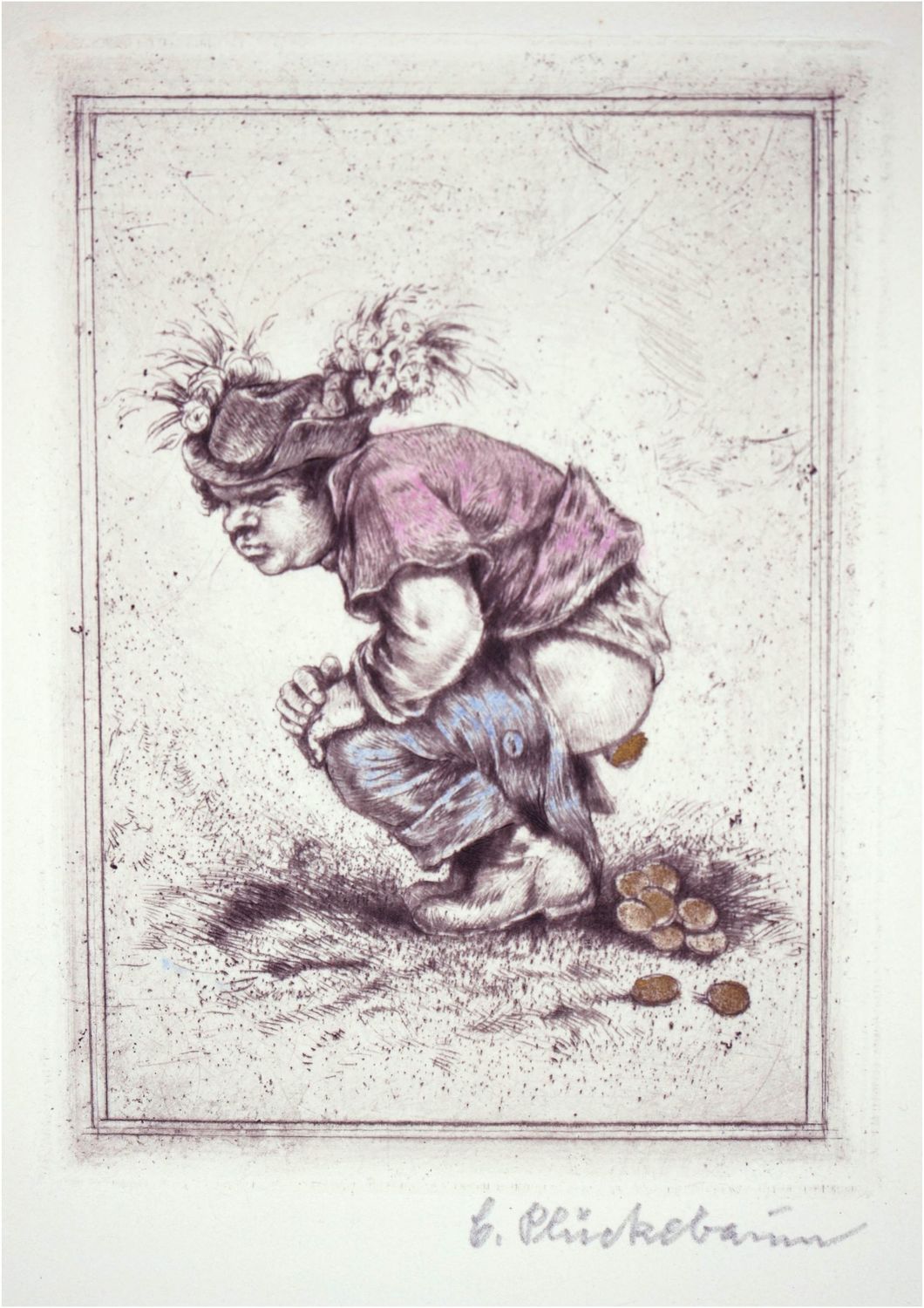Plückebaum, Carl (1880-1952), Der Talismann (sog. Dukatenscheisser)
Carl Maria Plückebaum(1880 Düsseldorf – 1952 ebd.), Der Talismann (sog. Dukatenscheisser), teilkoloriert Radierung, 11,5 x 8,5 cm (Plattengröße), 26,5 x 20 cm (Blattgröße), rechts unter der Darstellung mit „C. Plückebaum“ handsigniert und links unten mit „Der Talismann“ handbezeichnet.
- linke und rechte Außenseite des Blattes mit gebräuntem Streifen, sonst gutes Exe mplar
- Der Stein der Weisen -
Hier lässt Carl Plückebaum seinem antiakademischem Impetus freien Lauf und wendet den subtilen Humor seiner Bilder ins Derbe. Im Anschluss an die ihre Notdurft verrichtenden Bauern eines Adrian Ostade sehen wir einen feisten Kerl in hockender Position. Seine Ausscheidungen sind allerdings nicht der organische Verdauungsrest, sondern – wie beim Goldesel des Grimmschen Märchens – Dukaten. Sie wirken jedoch eher braun als golden, was durch die dezente handkolorierte Farbgebung des Bildes umso mehr hervortritt. Konterkariert wird die unschöne Ansammlung von den Blüten, die den Hut des Hockenden schmücken. Ganz in seine Handlung vertieft, zeichnet sich seine Tätigkeit im angestrengten Gesichtsausdruck ab, womit Plückebaum dem Begriff des Naturalismus' eine ganz neue Wahrhaftigkeit verleiht. Die Bezeichnung „Der Talismann“ wendet den Naturalismus dann doch wieder ins Wunderbare und formuliert auf humorvolle Weise, dass auch diese Hinterlassenschaften ein ‚Wunder der Natur‘ sind.
zum Künstler
Aus armen Verhältnissen stammend war der gehbehinderte und kleingewachsene Carl Plückebaum zunächst als Kirchenrestaurator tätig. Nebenbei nahm er privaten Zeichenunterricht. 1901 erhielt er den hochdotierten ersten Preis des Düsseldorfer Kunstgewerbemuseums, wovon er sein Studium an der Düsseldorfer Akademie finanzieren konnte. Dort war er Schüler von Eduard von Gebhardt und Peter Janssen d. Ä., begann aber zusehends an der akademischen Lehre zu zweifeln. 1906 beteiligte er sich an einer Gruppenausstellung in der Städtischen Kunsthalle Düsseldorf, was gegen die Statuten der Akademie verstieß und zu seiner Entlassung führt. Der außerordentliche Erfolg beim Publikum bestätige ihn jedoch als Künstler und bescherte ihm die finanziellen Mittel, um eine Studienreise nach Italien anzutreten. Begeistert von Florenz, zog er sich in das Franziskanerkloster von Fisole zurück und war dort als Freskenmaler tätig.
Wieder in Düsseldorf widmete er sich zusehend Kinder- und Tierzeichnungen und war 1907 Gründungsmitglied der der sezessionistischen Künstlergruppe Niederrhein. 1910 brach er in Begleitung seiner Malerfreunde, Walter Ophey und Carl Schmitz-Pleis, erneut nach Italien auf und bereiste insbesondere Rom und Neapel. Anschließend hielt er sich in München auf, um in der Pinakothek die Alten Meister zu studieren. In den Schwabinger Künstlerkreise lernte er seine spätere Frau, die Malerin Meta Weber, kennen. In Düsseldorf waren Carl und Meta Plückebaum prominente Vertreter der dortigen Kunstszene und rege Mitglieder des Künstlervereins Malkasten.

